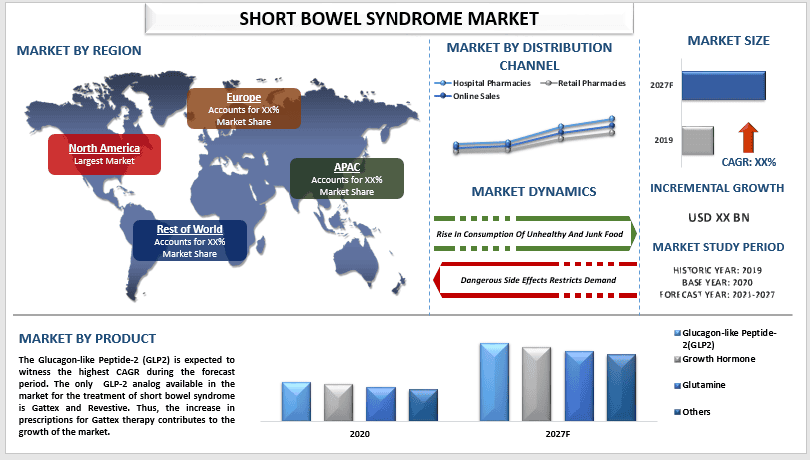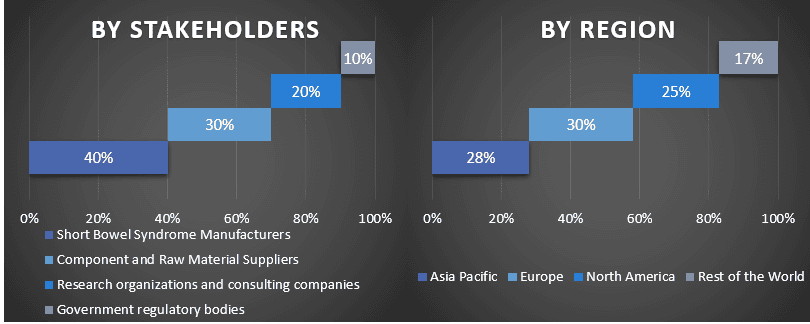- الرئيسية
- معلومات عنا
- صناعة
- الخدمات
- قراءة
- اتصل بنا
سوق متلازمة الأمعاء القصيرة: التحليل الحالي والتوقعات (2021-2027)
التركيز على المنتج (الببتيد الشبيه بالجلوكاجون-2 (GLP2)، هرمون النمو، الجلوتامين، أخرى)؛ قناة التوزيع (صيدليات المستشفيات، صيدليات البيع بالتجزئة، المبيعات عبر الإنترنت)؛ المنطقة/الدولة

من المتوقع أن يسجل سوق متلازمة الأمعاء القصيرة معدل نمو سنوي مركب قدره حوالي 27٪ خلال الفترة من 2021 إلى 2027. متلازمة الأمعاء القصيرة (SBS) هي اضطراب استقلابي ناتج عن خلل وظيفي أو استئصال للأمعاء الدقيقة بسبب جراحة لعلاج اضطرابات الجهاز الهضمي. تشمل الآثار الجانبية لهذه المتلازمة سوء الامتصاص والإسهال والإسهال الدهني واختلال توازن الماء والكهارل وسوء التغذية. يشمل العلاج الأولي لمتلازمة الأمعاء القصيرة الحفاظ على التغذية الجيدة ، وزيادة مساحة الامتصاص في الأمعاء المتبقية ، وتجنب المضاعفات. يرجع العدد المتزايد من حالات متلازمة الأمعاء القصيرة بشكل أساسي إلى الزيادة في الأمراض المتعلقة بالأمعاء ، والوراثة الجينية لـ SBS ، وما إلى ذلك. على سبيل المثال ، وفقًا للمعهد الوطني للسكري وأمراض الجهاز الهضمي والكلى ، تؤثر متلازمة الأمعاء القصيرة كل عام على ما يقرب من 3 من كل مليون شخص. علاوة على ذلك ، من المتوقع أيضًا أن ينمو سوق متلازمة الأمعاء القصيرة بسبب النمو في الإنفاق على الرعاية الصحية ، والتحسينات السريعة في مجال الرعاية الصحية قد زادت الوعي بهذا المرض ، وتقدم الحكومة الحكومية مع المنظمات غير الربحية حوافز خاصة للاعبين في السوق لأنها تعزز البحث والتطوير المتعلق بمتلازمة الأمعاء القصيرة.
تعد شركة Takeda Pharmaceutical Company Limited و Merck KGaA و Zealand Pharma A/S و OxThera و VectivBio AG و 9 Meters Biopharma Inc. و Nutrinia Ltd. و Hanmi Pharm.Co.، Ltd. و Pharmascience، Inc. و Nestle من بين اللاعبين الرئيسيين في السوق. وقد نفذ هؤلاء اللاعبون العديد من عمليات الاندماج والاستحواذ جنبًا إلى جنب مع الشراكات لتزويد العملاء بمنتجات / تقنيات عالية التقنية ومبتكرة.
رؤى مقدمة في التقرير
"من بين المنتجات ، استحوذت فئة الببتيد الشبيه بالجلوكاجون -2 (GLP2) على الحصة الأكبر في السوق في عام 2020"
بناءً على المنتج ، يتم تصنيف السوق إلى ببتيد شبيه بالجلوكاجون - 2 (GLP2) وهرمون النمو والجلوتامين وغيرها. من بين المنتجات ، استحوذت فئة GLP2 على حصة كبيرة من السوق. النظير الوحيد لـ GLP-2 المتوفر في السوق لعلاج متلازمة الأمعاء القصيرة هو Gattex و Revestive. تساهم الزيادة في الوصفات العلاجية لـ Gattex في نمو السوق.
"من بين قنوات التوزيع ، من المتوقع أن تشهد صيدليات المستشفيات أعلى معدل نمو سنوي مركب خلال الفترة المتوقعة"
بناءً على قنوات التوزيع ، يتم تصنيف السوق إلى صيدليات المستشفيات وصيدليات البيع بالتجزئة والمبيعات عبر الإنترنت. من بين هؤلاء ، من المتوقع أن تشهد صيدليات المستشفيات معدل نمو سنوي مركب كبير خلال الفترة المتوقعة بسبب الزيادة في عدد المرضى في أماكن المستشفيات وزيادة تنفيذ العلاج. علاوة على ذلك ، فإن تفضيل المرضى للتغذية الوريدية بأسعار معقولة وباهظة الثمن جنبًا إلى جنب مع الأدوية الموصوفة يساهم في حصة كبيرة من هذا القطاع.
"من المتوقع أن تشهد أمريكا الشمالية نموًا كبيرًا خلال الفترة المتوقعة"
لتحسين فهم ديناميكيات السوق لسوق متلازمة الأمعاء القصيرة ، تم إجراء تحليل مفصل لمختلف المناطق في جميع أنحاء العالم بما في ذلك أمريكا الشمالية (الولايات المتحدة وكندا وبقية أمريكا الشمالية) وأوروبا (ألمانيا وفرنسا وإسبانيا والمملكة المتحدة وإيطاليا وبقية أوروبا) وآسيا والمحيط الهادئ (الصين والهند وأستراليا واليابان وبقية منطقة آسيا والمحيط الهادئ) وبقية العالم. تشكل أمريكا الشمالية سوقًا رئيسيًا لمتلازمة الأمعاء القصيرة في عام 2020 بسبب الإيرادات المتأتية من Gattex ، وهو النظير الوحيد للببتيد الشبيه بالجلوكاجون -2 (GLP-2) المعتمد الذي يحسن امتصاص الأمعاء لدى المرضى الذين يعانون من SBS في الولايات المتحدة.
أسباب شراء هذا التقرير:
- تتضمن الدراسة تحليل تقدير حجم السوق والتنبؤ به تم التحقق منه من قبل خبراء الصناعة الرئيسيين الموثوق بهم.
- يقدم التقرير مراجعة سريعة للأداء العام للصناعة في لمحة.
- يغطي التقرير تحليلًا متعمقًا لأقران الصناعة البارزين مع التركيز الأساسي على البيانات المالية الرئيسية للأعمال ومجموعة المنتجات واستراتيجيات التوسع والتطورات الأخيرة.
- فحص تفصيلي للدوافع والقيود والاتجاهات الرئيسية والفرص السائدة في الصناعة.
- تغطي الدراسة بشكل شامل السوق عبر مختلف القطاعات.
- تحليل متعمق على المستوى الإقليمي للصناعة.
خيارات التخصيص:
يمكن تخصيص سوق متلازمة الأمعاء القصيرة العالمي بشكل أكبر حسب المتطلبات أو أي قطاع سوق آخر. إلى جانب ذلك ، تدرك UMI أن لديك احتياجات عمل خاصة بك ، لذلك لا تتردد في التواصل معنا للحصول على تقرير يناسب متطلباتك تمامًا.
جدول المحتويات
منهجية البحث لتحليل سوق متلازمة الأمعاء القصيرة العالمي (2021-2027)
كان تحليل السوق التاريخي وتقدير السوق الحالي والتنبؤ بسوق متلازمة الأمعاء القصيرة العالمي في المستقبل هي الخطوات الرئيسية الثلاث التي تم اتخاذها لإنشاء وتحليل اعتماد متلازمة الأمعاء القصيرة في المناطق الرئيسية على مستوى العالم. تم إجراء بحث ثانوي شامل لجمع الأرقام التاريخية للسوق وتقدير حجم السوق الحالي. ثانيًا، للتحقق من صحة هذه الرؤى، تم أخذ العديد من النتائج والافتراضات في الاعتبار. علاوة على ذلك، تم إجراء مقابلات أولية شاملة أيضًا مع خبراء الصناعة عبر سلسلة القيمة لسوق متلازمة الأمعاء القصيرة العالمي. بعد افتراض أرقام السوق والتحقق من صحتها من خلال المقابلات الأولية، استخدمنا نهجًا من أعلى إلى أسفل/من أسفل إلى أعلى للتنبؤ بحجم السوق الكامل. بعد ذلك، تم اعتماد أساليب تقسيم السوق وتثليث البيانات لتقدير وتحليل حجم سوق القطاعات والقطاعات الفرعية التي تنتمي إليها الصناعة. يتم شرح المنهجية التفصيلية أدناه:
اطلب المزيد من التفاصيل حول منهجية البحث
تحليل حجم السوق التاريخي
الخطوة 1: دراسة متعمقة للمصادر الثانوية:
تم إجراء دراسة ثانوية تفصيلية للحصول على الحجم التاريخي لسوق متلازمة الأمعاء القصيرة من خلال مصادر الشركة الداخلية مثل التقرير السنوي والبيانات المالية وعروض الأداء والنشرات الصحفية وما إلى ذلك، والمصادر الخارجية بما في ذلك المجلات والأخبار والمقالات والمنشورات الحكومية ومنشورات المنافسين وتقارير القطاعات وقاعدة بيانات الطرف الثالث والمنشورات الموثوقة الأخرى.
الخطوة 2: تقسيم السوق:
بعد الحصول على الحجم التاريخي لسوق متلازمة الأمعاء القصيرة، أجرينا تحليلًا ثانويًا مفصلًا لجمع رؤى السوق التاريخية وحصة القطاعات والقطاعات الفرعية المختلفة للمناطق الرئيسية. تضمنت القطاعات الرئيسية المدرجة في التقرير أنواع المنتجات والتوزيع. علاوة على ذلك، تم إجراء تحليلات على مستوى الدولة لتقييم الاعتماد الكلي لنماذج الاختبار في تلك المنطقة.
الخطوة 3: تحليل العوامل:
بعد الحصول على الحجم التاريخي لسوق القطاعات والقطاعات الفرعية المختلفة، أجرينا تحليلًا للعوامل بالتفصيل لتقدير الحجم الحالي لسوق متلازمة الأمعاء القصيرة. علاوة على ذلك، أجرينا تحليلًا للعوامل باستخدام متغيرات تابعة ومستقلة مثل المنتجات وأنواع التوزيع المختلفة لمتلازمة الأمعاء القصيرة. تم إجراء تحليل شامل لسيناريوهات جانب الطلب والعرض مع الأخذ في الاعتبار أهم الشراكات وعمليات الاندماج والاستحواذ والتوسع التجاري وإطلاق المنتجات في قطاع سوق متلازمة الأمعاء القصيرة في جميع أنحاء العالم.
تقدير حجم السوق الحالي والتنبؤ به
تحديد حجم السوق الحالي: بناءً على رؤى قابلة للتنفيذ من الخطوات الثلاث المذكورة أعلاه، توصلنا إلى حجم السوق الحالي واللاعبين الرئيسيين في سوق متلازمة الأمعاء القصيرة العالمي والحصص السوقية للقطاعات. تم تحديد جميع الحصص المئوية المطلوبة وتقسيمات السوق باستخدام النهج الثانوي المذكور أعلاه وتم التحقق منها من خلال المقابلات الأولية.
التقدير والتنبؤ: لتقدير السوق والتنبؤ به، تم تعيين أوزان لعوامل مختلفة بما في ذلك المحركات والاتجاهات والقيود والفرص المتاحة لأصحاب المصلحة. بعد تحليل هذه العوامل، تم تطبيق تقنيات التنبؤ ذات الصلة، أي النهج من أعلى إلى أسفل/من أسفل إلى أعلى، للتوصل إلى توقعات السوق لعام 2027 تقريبًا للقطاعات والقطاعات الفرعية المختلفة عبر الأسواق الرئيسية على مستوى العالم. تتضمن منهجية البحث المعتمدة لتقدير حجم السوق ما يلي:
- حجم السوق في الصناعة، من حيث الإيرادات (بالدولار الأمريكي) ومعدل اعتماد سوق متلازمة الأمعاء القصيرة عبر الأسواق الرئيسية محليًا
- جميع الحصص المئوية والتقسيمات وتقسيمات قطاعات السوق وقطاعاته الفرعية
- اللاعبون الرئيسيون في سوق متلازمة الأمعاء القصيرة العالمي من حيث الحلول المقدمة. أيضًا، استراتيجيات النمو التي يتبناها هؤلاء اللاعبون للتنافس في السوق سريع النمو
التحقق من صحة حجم السوق والحصة السوقية
البحث الأولي: تم إجراء مقابلات متعمقة مع قادة الرأي الرئيسيين (KOLs) بما في ذلك كبار المسؤولين التنفيذيين (CXO/نواب الرئيس، ورئيس المبيعات، ورئيس التسويق، ورئيس العمليات، والرئيس الإقليمي، والرئيس القطري، وما إلى ذلك) عبر المناطق الرئيسية. ثم تم تلخيص نتائج البحث الأولي وإجراء تحليل إحصائي لإثبات الفرضية المذكورة. تم دمج المدخلات من البحث الأولي مع النتائج الثانوية، وبالتالي تحويل المعلومات إلى رؤى قابلة للتنفيذ.
تقسيم المشاركين الرئيسيين في مناطق مختلفة

هندسة السوق
تم استخدام تقنية تثليث البيانات لإكمال تقدير السوق الإجمالي والتوصل إلى أرقام إحصائية دقيقة لكل قطاع وقطاع فرعي من سوق متلازمة الأمعاء القصيرة العالمي. تم تقسيم البيانات إلى عدة قطاعات وقطاعات فرعية بعد دراسة المعلمات والاتجاهات المختلفة في مجالات المنتج ونوع التوزيع في سوق متلازمة الأمعاء القصيرة العالمي.
الهدف الرئيسي لدراسة سوق متلازمة الأمعاء القصيرة العالمي
تم تحديد اتجاهات السوق الحالية والمستقبلية لسوق متلازمة الأمعاء القصيرة العالمي في الدراسة. يمكن للمستثمرين الحصول على رؤى استراتيجية لترسيخ تقديرهم للاستثمارات على التحليل النوعي والكمي الذي تم إجراؤه في الدراسة. حددت اتجاهات السوق الحالية والمستقبلية الجاذبية الإجمالية للسوق على المستوى الإقليمي، مما يوفر منصة للمشارك الصناعي لاستغلال السوق غير المستغلة للاستفادة من ميزة المبادرة. تشمل الأهداف الكمية الأخرى للدراسات ما يلي:
- تحليل حجم السوق الحالي والمتوقع لسوق متلازمة الأمعاء القصيرة من حيث القيمة (بالدولار الأمريكي). أيضًا، قم بتحليل حجم السوق الحالي والمتوقع للقطاعات والقطاعات الفرعية المختلفة
- تشمل القطاعات في الدراسة مجالات المنتج وقناة التوزيع.
- تحديد وتحليل الإطار التنظيمي لصناعة سوق متلازمة الأمعاء القصيرة.
- تحليل سلسلة القيمة المتضمنة في وجود وسطاء مختلفين، إلى جانب تحليل سلوكيات العملاء والمنافسين في الصناعة.
- تحليل حجم السوق الحالي والمتوقع لسوق متلازمة الأمعاء القصيرة في المنطقة الرئيسية.
- تشمل الدول الرئيسية في المناطق التي تمت دراستها في التقرير منطقة آسيا والمحيط الهادئ وأوروبا وأمريكا الشمالية وبقية العالم.
- الملفات التعريفية للشركات في سوق متلازمة الأمعاء القصيرة واستراتيجيات النمو التي يتبناها اللاعبون في السوق للحفاظ على قدرتهم على الاستمرار في السوق سريع النمو
- تحليل متعمق على المستوى الإقليمي للصناعة
ذات صلة التقارير
العملاء الذين اشتروا هذا المنتج اشتروا أيضًا










